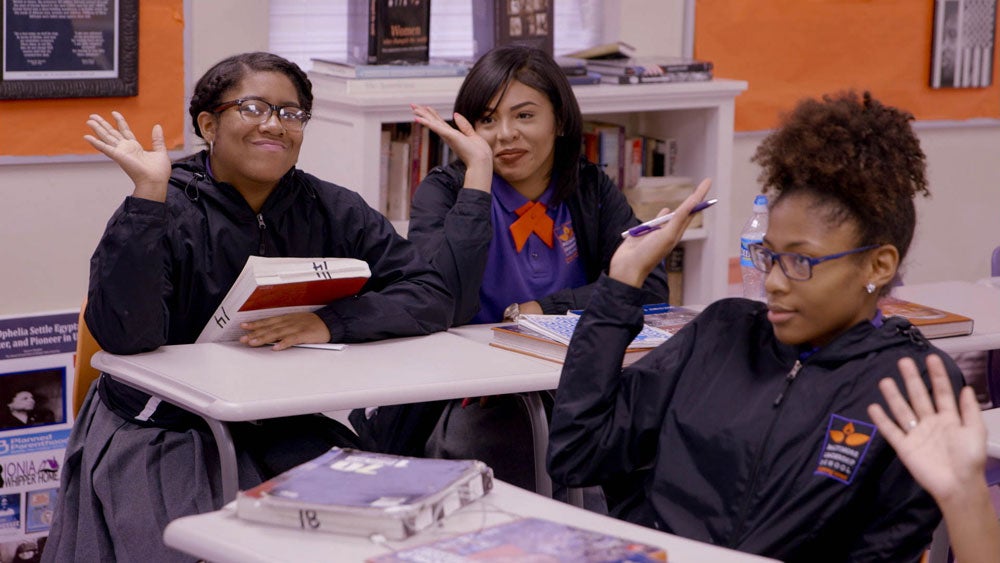Step details the story of three remarkable students and their senior year at the Baltimore Leadership School for Young Women (BLSYW). The women are part of the first graduating class from the college prep charter school’s first graduating class.
The film has received mixed reviews (including raves at Sundance). It arrives on the heels of Raising Bertie, another coming-of-age documentary featuring African-American youth struggling against intergenerational poverty, though in a rural setting. (I am already on record recommending people run — not walk — to see it.)

The young women of Step.
Not surprisingly, there are many connection points within the films and there are the lessons we can learn and share from them. Start with this realization: these are both full-length documentaries. Both films work hard to tell a true story. To be candid, Step feels vastly more sanitized to me, in part due to the performance of one remarkable student, Blessin, who looks like she floated down from central casting when, in reality, she was playing herself.
The documentaries both address how students from deeply entrenched intergenerational poverty (urban or rural) can find their way through high school and into college. These young people are most assuredly not alone in their struggles. Whether through sports, or shared activities in shared space or step dancing, these students learn to bond; they learn discipline and the value of team.
Both films ensure audiences understand that we have not yet seen the real life endings for these young people. Only time will tell where these six graduates will find themselves five or ten years from now. Will they graduate from college or some post-secondary institution? Will they be workforce ready when they do? Will the next generation of children we meet in the film thrive?
Both films provide insights into the families of these six young people and the schools they attend. Struggles are not hidden — everything from new stepparents, and food and housing insecurity to financial constraints and academic and interpersonal stresses and strains. In Raising Bertie, we get insights into the traditional high school in Bertie County and a well-performing charter program and school called the Hive. In Step, we see the insides of the BLSYW and the power of its step dance program.
We learn that similar stories can and do emerge in starkly different settings, and that we need to dig deeper into the benefits and detriments of public dual gender schools, alternative schools and small charter schools for girls like BLSYM. We are made to understand the urgency to address entrenched urban and rural challenges and temptations that impact schools — wherever they are located. We need to learn what works, and we need to create ways to spread that solution across our nation.
For me, what is stunning about both films is the support team needed to enable these six students to thrive. Saying ‘it takes a village’ is an understatement. It takes dedication, commitment, knowledge and deep understanding of the students being served. It requires sensitive adults (experienced in toxic stress and abuse and trauma) willing to develop powerful interpersonal and personalized relationships with these students. The Hive and BLSYM exemplify compassionate schools and the compassionate school movement.
As amazing as these six featured students are, what stands out for me are the adults who are featured. In Raising Bertie, the most powerful adult voice is that of the director of the Hive, Vivian Saunders. In two words: clone her. In Step, there are several similar individuals who should also be cloned: Coach G, the Step coach who has her own powerful and shared story; Paula Dofat, the college guidance counselor; and the high school principal who has a scene with Blessin that brings one to tears.
What become clear, in the films and in the literature on the subject, is that connections between students and adults are central to success. Those adults can take many forms and be in many locations. But they need to exist. In a new book, I call this “reciprocity” because there are true engagements between the students and their adult ‘magic wands.’ These adults enable the students to pivot right and make better choices on a regular basis.
As expressed in Step, these adults are magic wands in human form. They are so committed to their students’ success that you want to scream: Why aren’t all children exposed to such talented educators day in and day out?
What is equally important in both films is the role (or absence) of parents and stepparents and grandparents and relatives. These individuals appear in all sorts of combinations and with a wide array of strengths and weaknesses — sometimes the same person exhibits both. Some of these adults disappoint their children; others are so involved, it seems that they are reliving their own failed childhood. African American birth fathers tend to be either conspicuously absent or in jail. Some of the jail scenes in Raising Bertie are heartbreaking.
If I were to pick one scene in both films that captures their shared message, it would be the high school graduations. There was pride, there was crying, there was visible and palpable emotion. For many of us who attended elite high schools and colleges or universities, these events are and were subdued. There was an expectation that this was only the beginning and graduation was inevitability. Not so in Baltimore or Bertie County. As president of a college with almost 50% Pell-eligible and 70% first-generation students, graduations were deeply moving and symbolic. There were tears and cheers. Human emotion spilled across the tent and families embraced the possibility that this inspiring group of young people was literally lifting up prior and future generations, breaking the cycle of poverty.
Step and Raising Bertie should not sadden us although both films are laden with sadness. Yes, poverty sucks. But, both films inspire. The young people are, to use a new term, lastic. They give us hope that the next generation truly can raise themselves up, stepping up literally and figuratively. The titles of these movies, Raising Bertie and Step, have broad and multi-leveled applications. Both need to be seen, discussed, reflected upon and disseminated broadly and with honesty, humility and a profound respect for the power of the human spirit housed in many young people and the adults who serve them.
Perhaps the greatest lesson of these films is that these young people and their successes are not unicorn stories. That can give all of us hope.
The Aspen Institute Financial Security Program presented an advance screening of Step and featured a follow-up discussion with the parents of one of the three remarkable young women featured in this documentary.

